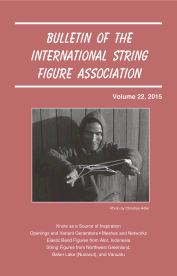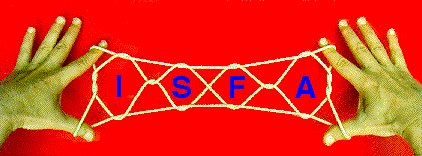Table of Contents - Volume 22 (2015): 242 pages
Edité par - Mark A. Sherman, Pasadena, California
Rédacteurs Associés - Joseph D'Antoni, Queens, New York; Myriam Namolaru, Haifa, Israel;
Belinda Holbrook, Davenport, Iowa; Stephan Claassen, Best, Netherlands.
Comité de Rédaction - Hiroshi Noguchi, Tokyo, Japan; Philip Noble, Inverness, Ecosse
Le Bulletin de l'Association Internationale du Jeu de Ficelle (BISFA) est une publication savante
présentant des documents originaux qui fait progresser notre compréhension et renforce
notre plaisir des jeux de ficelle. BISFA est publié annuellement, en septembre, par ISFA Press
(Pasadena, Californie). BISFA remplace le Bulletin de l'Association des Jeux de Ficelle,
(Toky Nippon Ayatori Kyokai), qui a été publiée en 19 volumes (1978-1993).
Les traductions proposées ne comprennent pas les illustrations et photos du texte original.
J'ai traduit ces textes pour vous donner un aperçu de la qualité et de la richesse de
ces publications.

![]()
Research Reports
- Knots as a Source of Inspiration by Martin Probert, Devonshire, UK (pages 1-9) - Occupational and decorative knots, in their almost infinite variety, can suggest new ways in which to manipulate a loop of string. This article illustrates a few of the possibilities, and indicates where more information can be found.
- Openings and Variant Generators by Martin Probert, Devonshire, UK (pages 10-21) - In this article we introduce the concept of a Variant Generator. We define a Variant Generator as a set of instructions that will generate all the variants of a given opening. Variant Generators are provided to generate all 4 variants of Opening A, the 16 variants of Murphy’s ‘hypothetical three loop openings’, the 12 variants of one of Murphy’s ‘Slant Openings’, and the 4 variants of Ornstein’s ‘Antipodal Opening A’. Openings F, N and X are then introduced, and Variant Generators are provided for the 24, 24 and 78 variants of these openings. A system of notation is introduced for identifying all these variants. We finally address the question, ‘What is an Opening?’
- Some Thoughts on the Process of making String Figures: Meshes and Networks by Philip D. Noble, Inverness, Scotland (pages 22-35) - The history of string figure recording owes a great debt to the Rivers and Haddon step by step recording process, and yet the very precision of description can lead to misunderstandings. String figures are best understood as a flow of movement that has been internalized and memorized involving the entire upper body. Most usually they evolve as a series of meshwork forms extended between the hands, and spread out by the fingers. In any particular culture the string figure repertoire appears to become relatively fixed when a number of figures have been developed, named and repeatedly taught. By specifically paying attention to the body movements in the making process, a greater understanding of the elements involved in string figure formation is gained. Recent developments suggest that many more figures await discovery.
- Quelques figures élastiques de l'île Alor, Indonesie par Stephan Claassen, Best, Hollande (pages 36-57) - Pendant l'été 2012 Benidiktus Delpada a filmé la construction de huit figures élastiques et une série de figures au village Tangfan-Takalelang de l'île d'Alor,Les Petites Iles de la Sonde, Indonesie. La construction de ces figures est descrite
- Some Inughuit String Figures (Northwest Greenland) as Filmed by Christian Adler in 1974 by Stephan Claassen, Best, Netherlands (pages 58-115) - In 1974 German ethnographer Christian Adler made a short film in which three Inughuit hunters from Keqertat in Northwest Greenland make string figures. The film shows 23 different string figures and tricks. The present paper presents transcriptions of the construction of these figures, along with a short introduction and comparative notes. Only two of the figures have not been encountered among the Inuit before. The construction of several of the figures shows small peculiarities. In 1862 or 1863 a small group of immigrants from Canadian Baffin Island arrived in the region. It is likely that they influenced the local string figure tradition, but the collection of string figures presented here shows only a few traces of such an influence.
- Some Harvaqtuurmiut String Figures, as made by Tatanniq in 1969 by Stephan Claassen, Best, Netherlands (pages 116-145) - Eleven different string figures are presented as they were made in 1969 by Tatanniq, a Harvaqtuurmiut Inuit, and filmed by Eugene Arima. Comparative remarks follow each figure. One figure (Baker Lake 8) is probably presented here for the first time. The construction method for another figure (Baker Lake 10) has been recorded previously. The collection contributes to our (still limited) knowledge of the string figure tradition of the cultural groups collectively known as Caribou Inuit.
- Some String Figures from Vanuatu by A. Bernard Deacon (1903-1927), and Mark Sherman, Pasadena, California (pages 146-212) - To date, substantial collections of string figures from all island groups in Melanesia have been published, except for the New Hebrides group (Vanuatu). In 1928, the Bishop Museum published instructions for making ten figures collected by Dickey from New Hebrides immigrants living on the Hawaiian island of Kauai, but almost nothing else has appeared since then, even though at least four scholars have subsequently collected string figures in Vanuatu. Cambridge anthropology student A. Bernard Deacon learned string figures while doing field work in the New Hebrides in 1926-27, but his string figure field notes were never published and attempts to locate them in publicly accessible archives have been unsuccessful. Recently, however, it was learned that the notes have been in private hands for many years. The notes include instructions for making thirty-two string figures learned from informants from four islands, namely, Santo, Ambrym, Malekula, and Tanna and are published here, as originally written in Rivers and Haddon nomenclature, for the first time. In a second section of this article the editor provides corrected instructions rewritten in standard ISFA nomenclature, as well as photographs of the final designs extended on the hands. A partial distribution analysis is also included.
Book Reviews - by Mark Sherman (pages 213-215)
- String Figures: The Collections of Harry Smith. Catalogue Raisonné, Volume II edited by John Klacsmann and Andrew Lampert. Text by John Cohen and Terry Winters.
Letters to the Editor (pages 216-221)
- Arctic String Astronomy Confirmed and Questioned - Céline Petit. Having read Alexey Andreev’s “Arctic Astronomy: Following the String” in last year’s Bulletin, the author corroborates and refutes some of his findings based on her own field work among the Inuit of Iglulik (Nunavut, Canada).
- On Cats and Sailors: Where is the Cradle? - Alexey Andreev. The author reexamines the origin of the term cat’s cradle by noting that sailors had a long-term tradition of keeping a cat onboard, and for those ship’s cats, sailors made special miniature hammocks to sleep in.
- On String Figures and Haiku Poetry: Two Arts of Emptiness - Alexey Andreev. As a practitioner of both art forms, the author explains how imagination plays a key role in the interpretation of both string figure designs and haiku poetry.
Nomenclature - by Mark Sherman (pages 222-237)
- Abbreviations and terms used throughout the Bulletin are summarized and illustrated. Step-by-step illustrations for making five string figures (Look!, Drum, Two Fawns, Face Mask, and Two Arrowheads) are provided as examples.
Ajouter un commentaire

